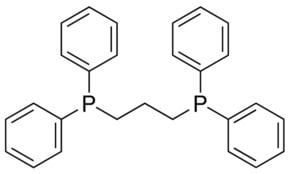Abbreviations DPPP Appearance white solid | Formula C27H26P2 | |
 | ||
1,3-Bis(diphenylphosphino)propane (dppp) is an organophosphorus compound with the formula (CH2)3(P(C6H5)2)2. The compound is a white solid that is soluble in organic solvents. It is slightly air-sensitive, degrading in air to the phosphine oxide. It is classified as a diphosphine ligand in coordination chemistry and homogeneous catalysis.
The diphosphine can be prepared by the reaction of lithium diphenylphosphide and 1,3-dichloropropane (Ph = C6H5):
2 Ph2PLi + C3H6Cl2 → C3H6(PPh2)2 + 2 LiClCoordination chemistry and use as co-catalyst
The diphosphine serves as a bidentate ligand forming six-membered C3P2M chelate ring. For example, the complex dichloro(1,3-bis(diphenylphosphino)propane)nickel is prepared by combining equimolar portions of the ligand and nickel(II) chloride hexahydrate. This nickel complex serves as a catalyst for the Kumada coupling reaction. Dppp is also used as a ligand for palladium(II) catalysts to co-polymerize carbon monoxide and ethylene to give polyketones. Dppp can sometimes be used in palladium-catalyzed arylation under Heck reaction conditions to control regioselectivity.
